Dartboard Setup
London Standard Dartboard Setup
Dartboard setup for a Standard Steel-tip London Dartboard
Steel tip Dartboard Setup
One of the most common questions is what height the dartboard should be and what is the throwing distance.
The standard dartboard used in competition darts has a set height and throwing distance, and this has been unchanged for over fifty years, but it wasn’t always this way. Dartboards in the UK varied, each having a unique set of rules and dartboard setup details. We now call these collectively UK Regional Dartboards. Some of the UK Dartboards are still available to purchase, and many still have regular leagues. Amongst these are the Yorkshire Dartboard, The Manchester Logend Dartboard and the London and Ipswich Fives (5s) dartboards.
Details of how to setup your dartboard to the official regulation height can be seen below. I have also included setup details for a Sift-tip dartboard plus wheelchair users' agreed height(s). UK Regional Dartboard can be seen in the table at the bottom of this page.
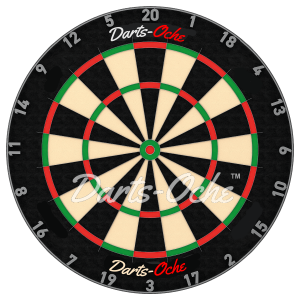
The history bit!
Many will read dartboard setup details in imperial measurements, feet (ft) and inches (“). However, it wasn’t until 1972 that the UK Government pushed through a change to enforce metric as the standard. Although British Industry wanted the change earlier, an anti-metrication motion held up the process, sighting the cost versus the benefits.
It is true to say the standard dartboard has been hung using the imperial measurements from this point. Yet tradition is hard to break, and over fifty years after the UK changed to metric, we still see imperial measurement being used alongside metric.
Imperial measurements are still used in the dart barrel threads! The most common 2BA. The larger thread 4BA is seldom used now, but if you have an old set of brass darts and have wondered what the thread or size being used, it is likely to be a 4BA.
Dartboard height and throwing distances in the UK and across Europe. Hence, dart mats sometimes have varied oche length markers. But before we fully go metric, some have asked why the distance was set at 7 feet 9 ¼ inches.
Standard throw distances were 7’, 7’,6”, 8’, and even 9’, but you could hardly play national and international events when one area used one setup and another used a different one.
The two main throwing distances were 7’6 and 8’. The 8’ distance was used in the News of the World Individual Championships. At the same time, a shorter distance was used in some parts of the UK for league darts. The compromise was to half the distance between the two, hence 7’9”, but wait a minute, where does the extra ¼” come from?
With metric distancing being adopted, 7’9” didn’t fit well on imperial measurements, so a ¼” was added so the throwing distance became 273cm.
So what about the height?
It is believed the average height of a man was used to set the height of the dartboard. From 1910 to 1930, the average height had little, if any, change by 5’8”. In the UK, the average height of a man is 5’10”, but as we all may have seen, height is neither an advantage nor a disadvantage in this sport.
The diagram below is for a standard dartboard setup. I only provide the metric details as fifty years is long enough for the imperial measurements now not to feature.
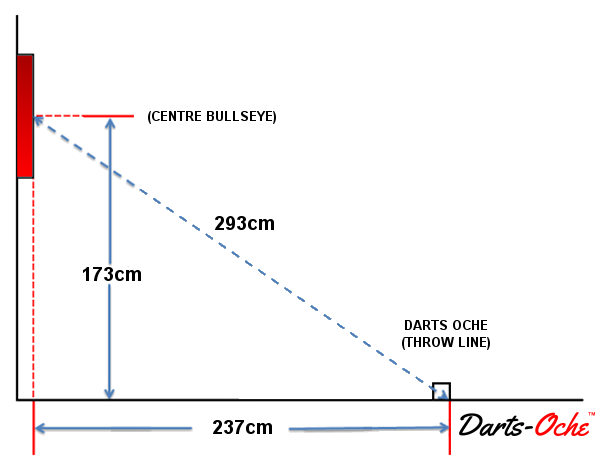
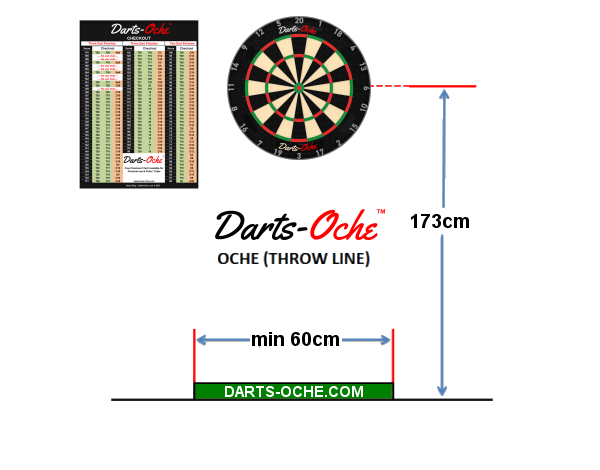
Depending on the dartboard you purchase, it will come with fixings. The standard fixings are shown here.
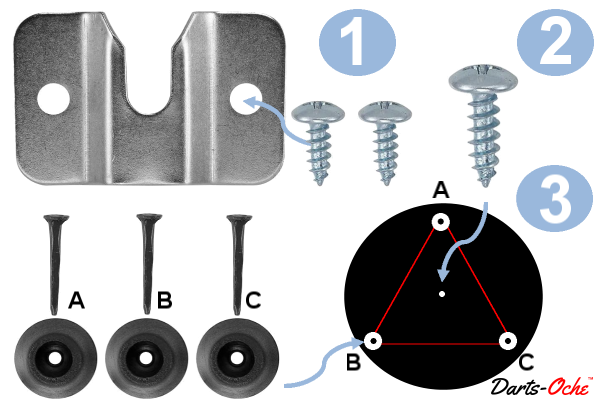
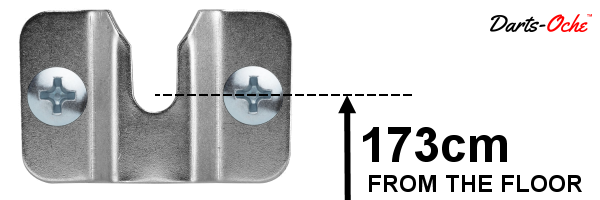
1. The Wall Fixing needs to be secure, so if you are not screwing into a wooden surface, you may require to drill and affix raw plugs.
2. The centre (large screw) is placed in the centre back of the dartboard. This will be marked for accuracy.
3. The stabilising feet are made from rubber and are nailed into place, spaced out as shown. Some dartboards come with a stabilising bent rigid metal strip. Unless you are using a professional dartboard hanging device, these are better as they flex and apply pressure to the back of the dartboard against the wall. This is especially helpful for uneven surfaces.
In some cases, the position where the three stabilisers should be placed is not marked on the rear of the dartboard.
Soft-tip Darts
Soft-tip darts setup is different. The dartboard is the same height, but the throwing distance is 244cm
Wheelchair users.
Wheelchair user dartboard height
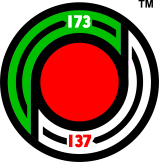 In 2010, Russ Strobel submitted to the Australian Darts a recommended dartboard height for wheelchair use. This was accepted and later accepted by the World Darts Federation (WDF) in October 2012, and adopted by the PDC in their stanging of the first PDC Disability Matchplay. Disabled wheelchair users throw from the same distance. However, the height of the board is lower at 137cm.
In 2010, Russ Strobel submitted to the Australian Darts a recommended dartboard height for wheelchair use. This was accepted and later accepted by the World Darts Federation (WDF) in October 2012, and adopted by the PDC in their stanging of the first PDC Disability Matchplay. Disabled wheelchair users throw from the same distance. However, the height of the board is lower at 137cm.
The revised height for the dartboard for a wheelchair user was established in two ways.
Firstly, the average height of seated wheelchair users was measured. The height wasn’t 137cm, but Russ thought for the minimal difference, 137cm would be easier for all to remember due to the standard height being 173cm. Indeed it is; just a reversal of the two last figures makes it easy to remember.
Players using wheel chars may have the front wheels over the oche throwing line, but the rear wheels must remain behind. The rear wheels are allowed to butt up to the raised oche. However, if their disability permits, many wheelchair players prefer to play side-on with both sets of wheels behind the oche. In addition, a wheelchair user may have a dart retriever, unlike a non-disabled player who must retrieve their own darts.
Disability Setup Dia
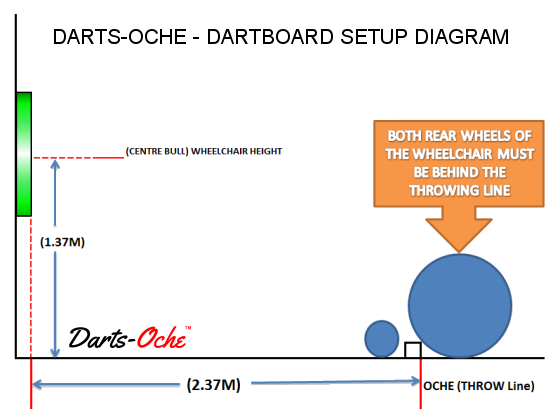
Other Dartboard Setups
Unless you have a special UK Regional Dartboard, the only setup you are likely to use is the above. However, below is a table of the setups for the UK Regional Dartboards. Regional variation may differ from the detail I have supplied here. However, I have consulted the former Manchester Log-end League chairman John Gwynn for the Official League details. I have also been provided with an alternative Manchester* Dartboard League setup, so I have supplied both. I again had confirmed the Yorkshire dartboards by John Lowe and his friends in Yorkshire.
The London Fives Darts League has confirmed the London Fives setup. As for the Ipswich Fives, I have provided the Standard Dartboard setup. It may be the same as the London. However, I need confirmation from an Ipswich Fives League team to confirm.
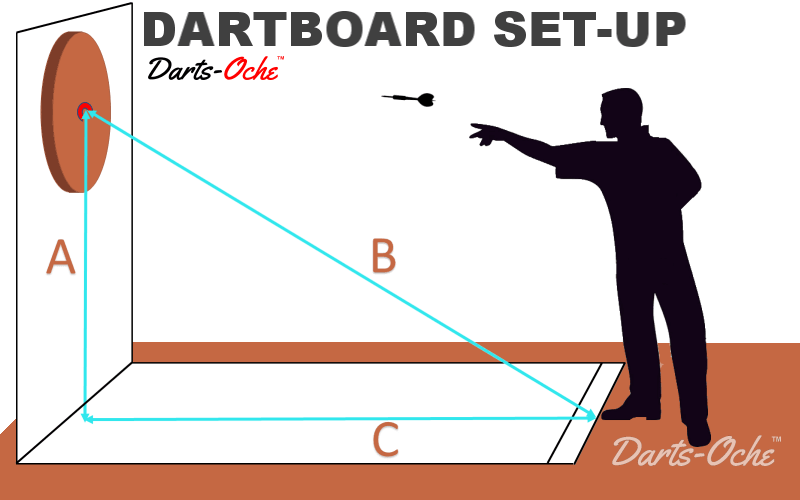
The figures here are rounded to the nearest CM and 1/4". Modern setups use metric measurements however I have shown both for reference.
| Dartboard | A: Height to Centre Bull | B: Centre Bull to Oche | C:Throw Distance |
| Standard (London) | 5' 8" / 1.73m | 9' 7 ½" / 2.93m | 7' 9 ¼” / 2.37m |
| Standard (Wheelchair User) | 4' 6" / 1.37m | 9' 0" / 2.74m | 7' 9 ¼” / 2.37m |
| Soft-tip | 5' 8" / 1.73m | 9' 9 ¾" / 2.99m | 8' 0" / 2.44m |
| London Fives (Narrow Fives) | 5' 6" / 1.68m | 10' 6" / 3.20m | 9' 0” / 2.743m |
| Ipswich Fives (Wide Fives) TBC | 5' 8" / 1.73m | 9' 7 ½" / 2.93m | 7' 9 ¼” / 2.37m |
| Manchester (Official) | 5' 3" / 1.60m | 9' 2" / 2.79m | 7' 6" / 2.29m |
| Manchester* | 5' 6" / 1.68m | 9' 3 1/5"/ 2.84m | 7' 6" / 2.29m |
| Yorkshire | 5' 6" / 1.68m | 9' 0" / 2.74m | 7' 2" / 2.18m |
| Lincolnshire (15" dia Dartboard) | 5' 8" / 173 cm | 9' 0" / 274 cm | 7' 0" / 213.4 cm |

